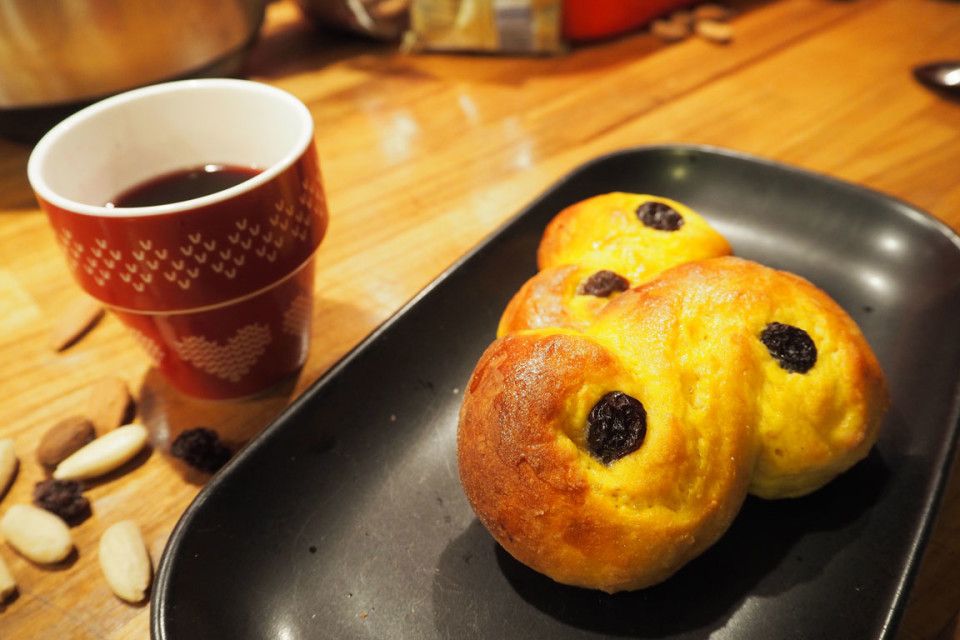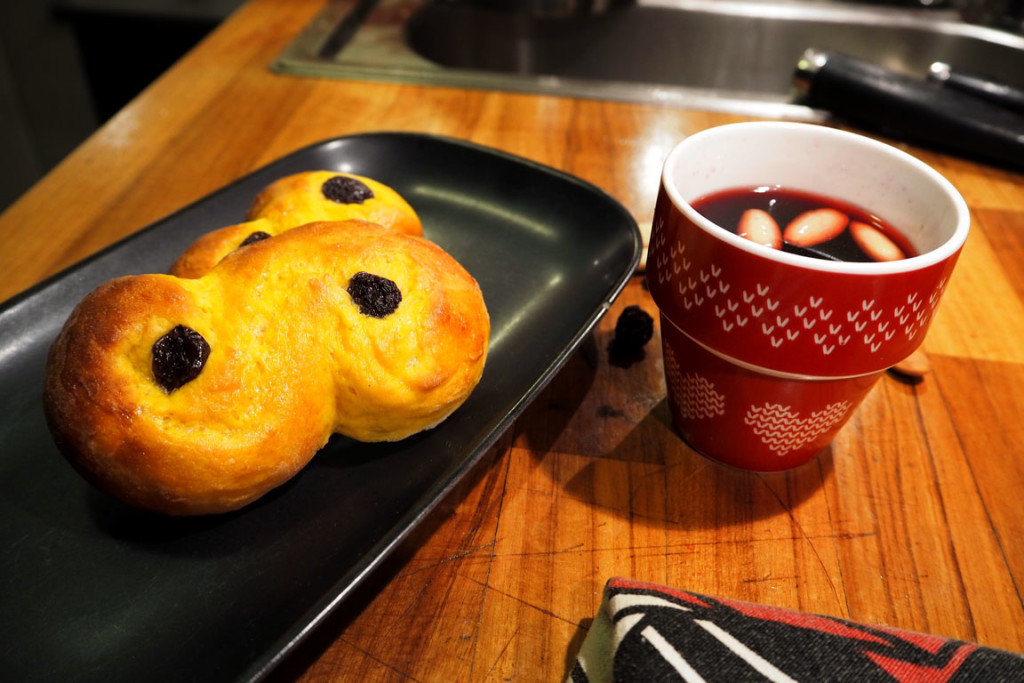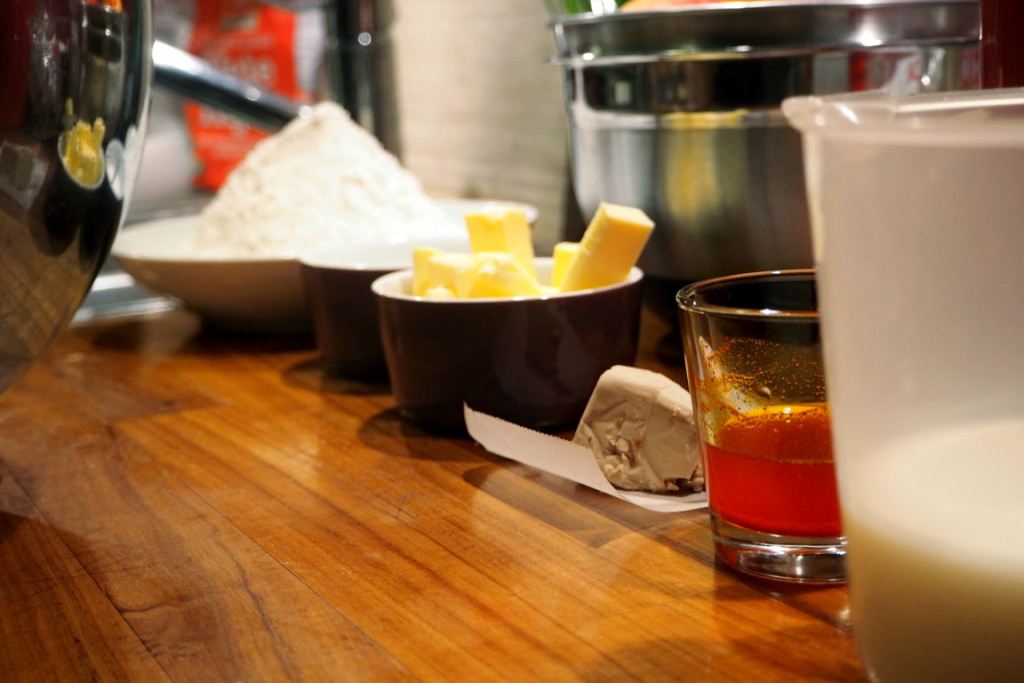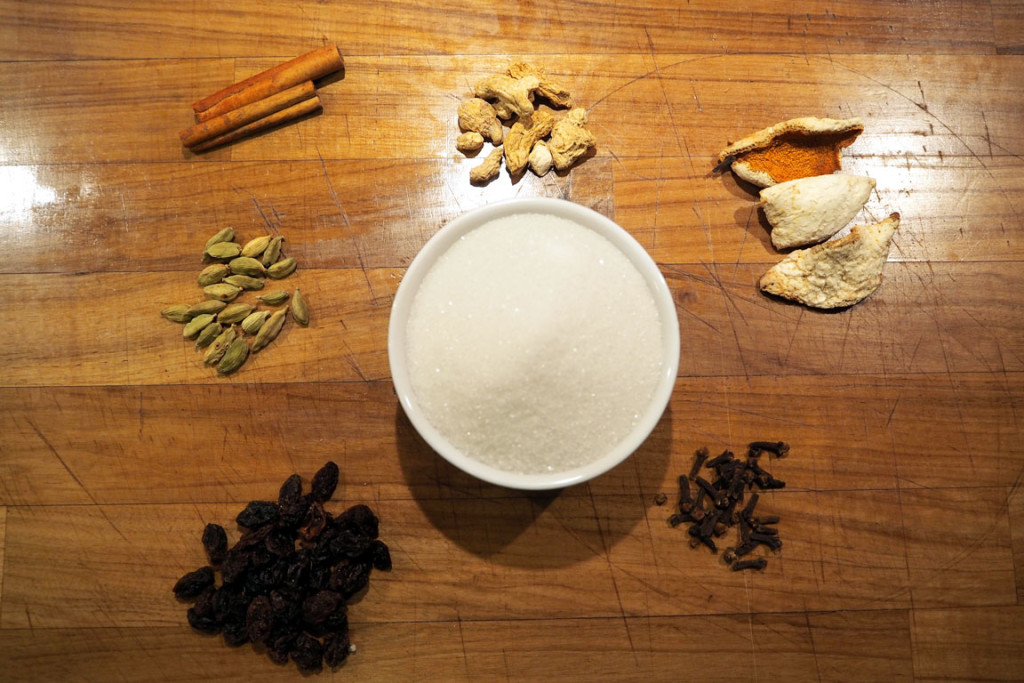Lussebullar & Glögg (Swedish saffran buns & Swedish mulled wine)

Glögg is a Swedish mulled wine available in pretty much every Swedish home around Christmas. The strong one for grown ups, and non-alcoholic for the children.
Many Swedes like to think about glögg as something unique for Sweden or at least for the Nordic countries, but mulled wine is made and consumed all over Europe. In Germany they have Glühwein (from which the name glögg derives, by the way). In the UK, mulled wine is quite common. France and Switzerland has vin chaud ‘hot wine’. Italians have “vin brûlé” (the name is actually French and means ‘burned wine’). The Romanians have vin fiert, Serbs drink kuvano vino, and Poles have their grzane wino. In Slovakia you’ll find varené vino, and in Russia глинтвейн, in the Czech republic svařené víno, in Slovenia kuhano vino and in Hungary the forralt bor. They all have one thing in common with Swedish mulled wine: they’re warm. And almost all of them have another thing in common, they’re heavily spiced.
As for lussebullar (plural of lussebulle), they are sweet saffran buns baked around Christmas, by pretty much every Swedish family you’ll ever meet. The “bulle/bullar” means bun/buns, and the etymology of lusse isn’t perfectly clear. It is believed they were first introduced in Sweden by germans around 1600.
According to legend, the devil was running around beating up naughty children while Jesus walked around handing out buns to good children. People that decided not to wait for Jesus to hand out buns, baked them themselves and added saffron to give them a nice yellow color. A color that was said to keep the devil away. Yes, I know, the story makes no sense. It is known, however, that the buns were called “dövelskatter” or “dyvelskatter” in western Sweden up until as late as 1897. That literally means “devil cats”. Some say, this explains its current name “lussekatt”. Lusse as in “lucifer”. Oh my, this doesn’t sound like something you’d bake for Christmas, does it? Don’t worry. According to the dictionary of the Swedish Language Academy, the word “lussebulle” and “lussekatt” comes from Lucia, an Italian saint. Which makes sense, considering Swedes celebrate Lucia during the weeks leading up till Christmas Eve.
Let’s leave the etymology at that for a moment, and concentrate on the gastronomy. Lussebullar, when done right, are very moist and soft and wonderful. Sweet, but not too sweet, because they’re often enjoyed together with mulled wine which in itself is very sweet. The combination is just wonderful.
Many recipes call for quark as an ingredient. It supposedly makes the buns moist and soft. According to Magnus Johansson, a master baker who does the deserts for the Swedish Nobel Prize ceremony, that’s a myth. Ann-Charlotte Eliasson, professor of chemistry specialized in studies of gluten at Lund University, agree with Johansson. She says what makes these buns so soft and keeps them from becoming dry, is the high amount of fat and sugar. Having said that, I still have quark in mine. For the sake of fat and protein content.
Ingredients for Swedish saffran buns
- 25 g fresh yeast (if you’re in a country where fresh yeast is hard to obtain, you’ll have to settle with dry yeast. It needs some more time to wake up, but you’ll manage)
- 150 g smör eller margarin
- 0,5 g of whole saffron (by whole, I mean whole pollen, like the ones you see in the video. If you can’t find that, use normal saffron, same quantity)
- 95 g of sugar (that’s about 95 grams)
- 2,5 dl of milk
- 250 g of quark (as high fat content as you can find. Quark is sold in most countries where dairy products are popular. Except France, you’ll have troubles if you’re in France in which case you can try using Fromage blanc. If you don’t find quark with at least 10% fat content, mix it with full cream. Or swap it for crème fraîche, I tried that in France once and it gave the buns a somewhat more tangy taste but still very good)
- pinch of salt (by pinch, I mean about 1/4 teaspoon or 1,5 grams)
- 1 ägg (for brushing)
- A handful of raisins, enough for two per lussebulle bun.
- 480 grams of wheat flour (that’s around 8 dl)
- 2 tbsp or dark rum
Ingredients for Swedish mulled wine
- 15 g of raisins
- 3 g of whole cardamom pods (that’s about 10 of them)
- 2 g of cloves (that’s 5 pieces)
- 7 g of dried ginger (look at the quantity I’m using)
- 6 g of cinnamon (about 2 sticks)
- 7 g of dried bitter orange (that’s the peel from about half a fresh bitter orange)
- A couple of handful of almonds to serve. If you want to be a fancy Swede, use peeled almonds.
- 75 cl of dry wine (that’s about a standard size bottle)
- 150g sugar (a little more than 1,5 dl)
This is how you make the lussebullar
- Make sure all ingredients are room temperature.*
- Put the raisins in cold water, and let them soak there while you prepare the rest.
- Crumble up the fresh yeast into a bowl. If you’re using dry yeast, add a splash of lukewarm water and leave it for a few minutes.
- Put the whole saffron into a pestle together with some of the sugar, and grind it upp.** Put it into the rum and set aside.
- Mix in all the liquids.*** Milk and saffron-rum, that is. And the quark!
- Add sugar, salt and flour. Sieve the flour!
- Kneed the dough in a stand mixer for about 10 minutes, or by hand for about 20. Until it’s not sticking to your fingers any more. It doesn’t have to be perfect, the osmosis effect will help it become more elastic over time. Leave it to double in size.
- Cut the dough into about 20 pieces, and make little worms that you curl into the classic lussebulle shape.
- Put two raisins in each lussebulle.
- Let them prove on a baking sheet, on a baking tray, until almost double in size.
- Heat the oven to 225 degrees Celsius. Brush the lussebullar with a beaten egg and some water, and put them into the oven. Bake them for about 8-10 minutes. If you’re prepared to screw up everything due to not knowing exactly how warm your oven is, or how big the lussebullar are, just hope for the best. But I do really recommend that you put three in there, and try different times. The soft and moist one wins. The dry one doesn’t. Then repeat the winning time with the rest of the buns.
Lussebullar recipe notes
* It will make a lot of things easier for you, from mixing in the butter to having the dough prove within reasonable time.
** The sugar will make the process easy.
*** Some recipes call for heating the milk or melting the butter, but none of that really matters. The dough will prove anyway. Hey, I’ve even made cold proved doughs, resting in the refrigerator over night. However, if you want to speed things up a little, you can always use a hairdryer to quickly heat up the bowl and the yeast. I’m not kidding, hair dryers in the kitchen can to a lot of things!
This is how you make the Swedish mulled wine
- Empty a bottle of wine in a large sauce pan or pot, or whatever heatable container you have.
- Put all the spices in there together with the sugar.
- Let simmer for at least an hour. There’s no such thing as “too long” for this.
- If you feel the need of getting drunk. What do I know, some people do? Add vodka before serving.
- Serve with raisins and almonds, just like a real Swede would. Just pour the wine into a mug, and drop a couple of raisins and almonds in there.
Enjoy your Swedish mulled wine and saffran buns! And Merry Christmas!




